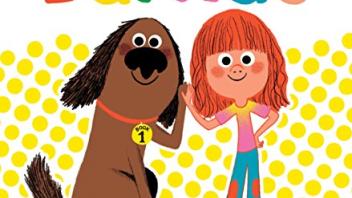
Biography
When Norman Bridwell first visited children’s publishing houses in 1962, one drawing in his portfolio was of a little girl and a big red dog. Little did Bridwell know, this idea would evolve into a global phenomenon, helping him to sell over 44 million books. Bridwell claims that “luck has a lot to do with it,” but without his adorable illustrations, playful humor, and childlike imagination, Clifford would not have become one of the world’s most beloved dogs. Children love to see what Clifford the Big Red Dog will do next, whether it’s putting out a fire, joining the circus, or just doing tricks.
Growing up in Kokomo, Indiana, Norman Bridwell was always drawing. “I was not good at sports and my high school shop teacher, after a few days of class, took my tools away, telling me ‘Here’s a pad of paper instead. You seem to like to draw: stick to that,’” Bridwell remembers. But not everyone believed his drawings or writing would someday delight millions of children (and parents and teachers) around the world, a point he likes to stress during his frequent visits to schools. “I always liked to draw,” Bridwell tells children, “but I was never considered very good. In school there was always someone better than me; the art teacher always liked their work better than mine. Teachers didn’t like my writing either.”
After high school, Bridwell wanted to turn his love of drawing into a career. He studied first at the John Herron Art Institute in Indianapolis and then moved to New York, where he took classes at another art school, Cooper Union, for two years. He then went to work as a commercial artist. It was in 1962, while he was working as a freelance filmstrip and slide illustrator and drawing mostly cartoons, that Bridwell decided to put together a portfolio of colorful drawings and make the rounds of children’s book publishers. By then married, with an infant daughter – Emily – he was hoping to supplement his income with some extra work illustrating books.
Bridwell visited about fifteen publishing houses, but there were no assignments to be had, and even worse, seemingly little hope for any in the future. One editor at Harper & Row went so far as to tell Bridwell that his art by itself was just not good enough, and she didn’t think anybody would ask him to illustrate a book for them. But amazingly enough, she also made the suggestion that helped bring him the phenomenal success he enjoys today. She advised him to write a story to go along with one of his pictures. She picked out his sketch of a baby girl and a horse-sized bloodhound and casually said, “There might be a story in this,” Bridwell remembers.
All-Around Dog
He wasted no time in taking her advice, but he did decide to make the bloodhound even bigger and more of an “all-around” dog – much like the dog he had wanted as a little boy, one that he could ride and who would be a fun companion. Bridwell remembers speaking to the editor on a Friday, and “by Monday, I had done this little book about a girl and her dog,” he says.
Now all he needed were names for his characters. “I wanted to call the dog ‘Tiny,’ but Norma [his wife] said that was boring and suggested ‘Clifford’ after an imaginary friend from her childhood,” Bridwell says. The little girl’s name, however, was easy. Bridwell named her Emily Elizabeth, after his young daughter. He dropped off his drawings and manuscript at Scholastic and tried not to expect anything.
Three weeks later the phone rang. Scholastic wanted to publish Clifford the Big Red Dog. At the time, Bridwell couldn’t quite believe it. “I said to my wife, ‘Now don’t count on there being any more. This one is just a fluke. I don’t know if there will ever be another one.’” But it was no fluke – so far over forty Clifford books have been published. But Bridwell, who now has been a best-selling author-illustrator for years, still refuses to take all the credit for his spectacular success. “Luck has a lot to do with it,” he modestly insists. “So much of it has to do with stumbling into the right characteristics of this big red dog and situations you can use in a story.”
“He’s Red and He’s Warm”
Bridwell sums up Clifford’s characteristics matter-of-factly: “He’s red and he’s warm. Clifford does what you’d like to do but can’t. Because Clifford is so big and also because he’s a dog, he’s able to do the most unbelievable and imaginative things.” But not too unbelievable or imaginative. You won’t see Clifford traveling in outer space, for example. Bridwell is firm about his decision that Clifford won’t do anything that a real dog wouldn’t do.
Although Clifford books are based on rather ordinary events, such as camping, going to the seashore, or the circus, when the Big Red Dog comes on the scene, things start to happen! “Clifford always tries to do the right thing,” Bridwell explains, “but he does make mistakes.” Bridwell gets the ideas for Clifford’s behavior from other dogs – dogs in movies, dogs in stories, and, of course, dogs he’s watched over the years, including his own. After Bridwell decides what will happen in the story, he sketches it out. Next, he writes the text – first just letting the story flow and later revising it. From start to finish, the process usually takes about three months.
Despite his (and Clifford’s) success, Bridwell, like anyone who does anything creative, still can’t always predict how others will respond to his work. In just a few hours, on the night before he was to meet with his editor about a Clifford book that he had worked on for many weeks, Bridwell drew some sketches and put together the text for what would become one of his most popular books, The Witch Next Door. Bridwell thought he was just bringing along something extra, but The Witch Next Door, about a kindly witch and her friendship with her two young neighbors, was accepted for publication while the Clifford book was rejected. “That’s the way it goes,” Bridwell says, calling The Witch Next Door a “happy accident.”
“Someday You Will Succeed”
But what he has obviously learned and what he tries to stress to young writers is that rejection is not a reason to give up. “Sometimes you’ll do something that you really like and no one else does. You’ll feel terrible, but you’ve just got to press on and keep trying. If you like doing it and keep working at it, then someday you will succeed.”
Norman Bridwell certainly has succeeded. There are over 44 million copies of his books in print and many of his stories are translated into other languages.
Norman Bridwell now resides on Martha’s Vineyard with his family, where he enjoys beachcombing, photography, and, of course, creating new tales and drawings for his fans the world over.












